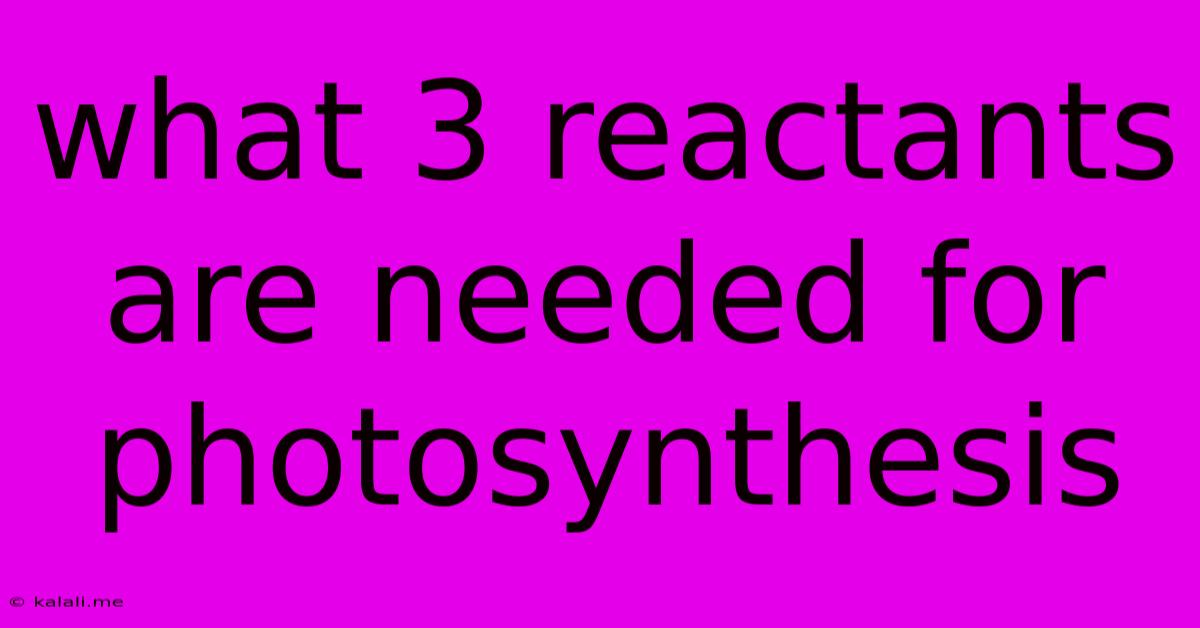What 3 Reactants Are Needed For Photosynthesis
Kalali
May 10, 2025 · 3 min read

Table of Contents
What 3 Reactants Are Needed for Photosynthesis? A Deep Dive into the Process
Photosynthesis, the remarkable process by which plants and other organisms convert light energy into chemical energy, requires a precise combination of reactants. While often simplified, understanding the true input materials provides a deeper appreciation of this fundamental biological process. This article will explore the three key reactants needed for photosynthesis: carbon dioxide, water, and light energy. We'll delve into the role of each, and how they work together to power life on Earth.
1. Carbon Dioxide (CO2): The Building Block
Carbon dioxide, a gas present in the atmosphere, serves as the primary source of carbon atoms in photosynthesis. These carbon atoms are the essential building blocks for creating glucose, a simple sugar that stores the captured energy. Plants absorb CO2 through tiny pores on their leaves called stomata. The concentration of CO2 in the atmosphere directly impacts the rate of photosynthesis; higher concentrations generally lead to faster rates, up to a certain saturation point. Factors like environmental conditions and plant species influence this optimal CO2 level. Understanding the role of CO2 is critical to comprehending climate change's impact on plant life and global ecosystems.
2. Water (H2O): The Electron Donor & More
Water plays a dual role in photosynthesis. Firstly, it serves as an electron donor. During the light-dependent reactions, water molecules are split (photolysis) to release electrons, which are crucial for the electron transport chain. This process also releases oxygen (O2) as a byproduct, the very oxygen we breathe. Secondly, water is essential for various metabolic processes within the plant cell, supporting overall plant health and the efficiency of photosynthesis. Water availability, therefore, significantly affects photosynthetic rates. Droughts, for example, can severely limit photosynthesis due to water stress in plants. The importance of water extends beyond just providing electrons; it's a vital component of the entire photosynthetic machinery.
3. Light Energy: The Energy Source
Light energy, specifically visible light within the electromagnetic spectrum, provides the driving force for photosynthesis. Chlorophyll, the green pigment in plants, absorbs light energy, primarily in the red and blue wavelengths. This absorbed energy excites electrons in chlorophyll molecules, initiating the electron transport chain and powering the subsequent reactions. The intensity and quality (wavelengths) of light significantly influence photosynthetic rates. Plants adapted to shade will have different light absorption characteristics compared to those in full sunlight. Understanding the role of light energy is key to optimising agricultural practices and designing efficient artificial photosynthesis systems.
Beyond the Basics: A Holistic View
While carbon dioxide, water, and light energy are the essential reactants, it's important to remember that photosynthesis is a complex process involving numerous enzymes, cofactors, and other molecules. Optimal temperature, appropriate pH levels, and the availability of essential minerals all contribute to the efficiency of this remarkable process. By understanding the fundamental requirements and their interactions, we can appreciate the intricate design of photosynthesis and its importance for life on Earth. Furthermore, this knowledge informs various applications, from improving crop yields to developing sustainable bioenergy sources.
Latest Posts
Latest Posts
-
How Many Mm Is 1 3 4 Inches
May 10, 2025
-
10 Is 40 Percent Of What
May 10, 2025
-
55 Cm To Feet And Inches
May 10, 2025
-
7 5 Cm Is How Many Inches
May 10, 2025
-
19 Degrees In Fahrenheit To Celsius
May 10, 2025
Related Post
Thank you for visiting our website which covers about What 3 Reactants Are Needed For Photosynthesis . We hope the information provided has been useful to you. Feel free to contact us if you have any questions or need further assistance. See you next time and don't miss to bookmark.